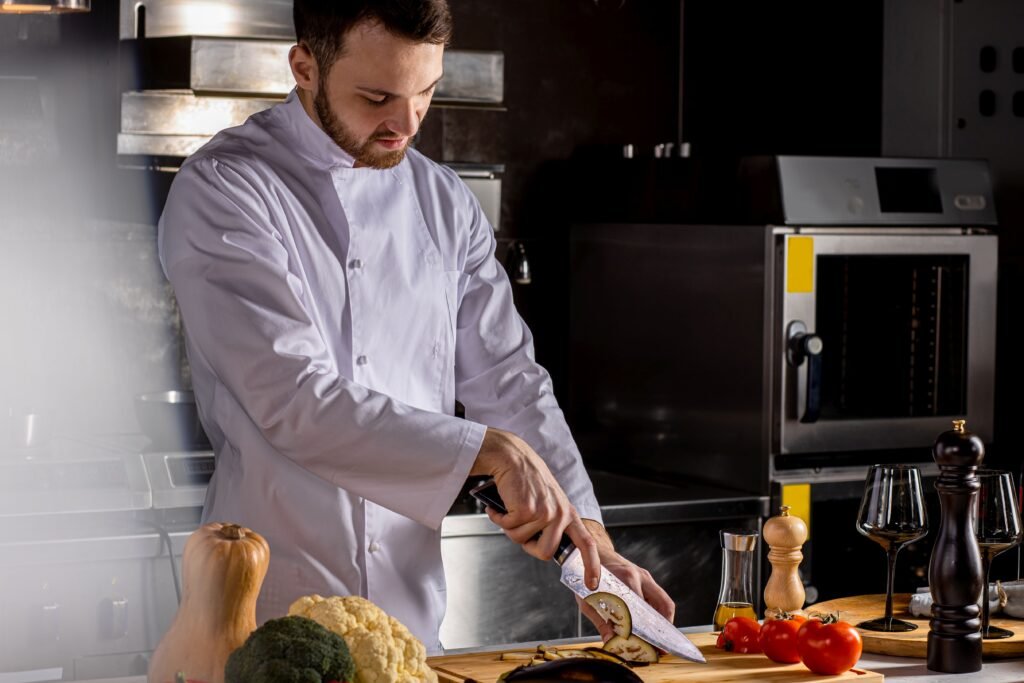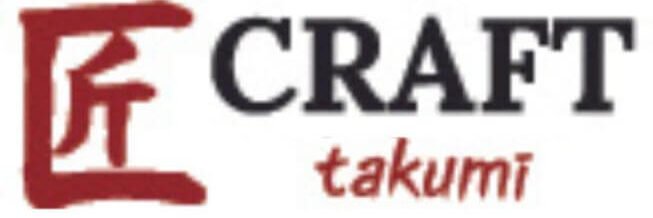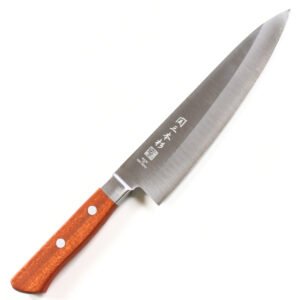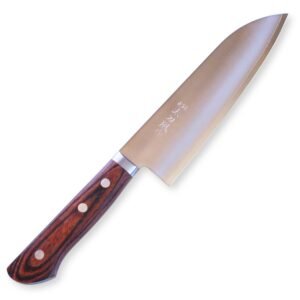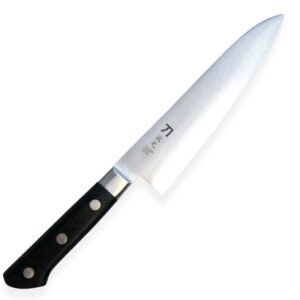The blades of the knives we use every day come in a variety of materials. For home use, stainless steel is the most common, but other materials such as carbon steel, ceramic, and powder high-speed steel are also widely available on the market.
These materials greatly influence the knife’s hardness, wear resistance, toughness, and corrosion resistance, which affect not only usability and lifespan but also sharpness and maintenance requirements. Additionally, even within stainless steel or carbon steel, different grades determine the quality and price, making the selection process enjoyable.
Here, we’ll take a closer look at the types of materials used in knives and their unique characteristics.
About Carbon Steel (鋼, Hagane) Knives

Carbon steel (鋼, Hagane) knives are made from steel, a material created by adding carbon to iron. While pure iron contains impurities that make it prone to rust and brittleness, the addition of carbon enhances its strength and hardness, resulting in steel with excellent cutting ability. This transformation makes carbon steel widely used for knife production.
By adding carbon, the steel becomes harder, allowing for a sharp cutting edge that performs exceptionally well. However, the increased hardness also makes the material more brittle and susceptible to rust. For this reason, regular maintenance is essential to keep carbon steel knives in optimal condition.
Pros :
- Exceptional cutting ability due to sharp edges
- Enhanced hardness for superior performance
Cons :
- Rust sensitivity
- Brittleness increase
- Routine maintenance required
In Japan, carbon steel is classified based on its carbon content and other elements, with common types such as Blue Paper Steel (青紙鋼, Aogami Steel), White Paper Steel (白紙鋼, Shirogami Steel), and Yellow Paper Steel (黄紙鋼, Kigami Steel). These steels vary in hardness, durability, ease of sharpening, and rust resistance, and are chosen based on the intended use and personal preferences. Carbon Steel (鋼, Hagane) knives are primarily used in Japanese kitchen knives and are particularly favoured by chefs for sushi, sashimi, and other Japanese dishes where a sharp cutting edge is essential.
Carbon Steel (鋼, Hagane) knives are primarily used in Japanese kitchen knives and are particularly favoured by chefs for sushi, sashimi, and other Japanese dishes where a sharp cutting edge is essential.

Please note: We currently do not stock carbon steel kitchen knives.
About Stainless Steel Knives
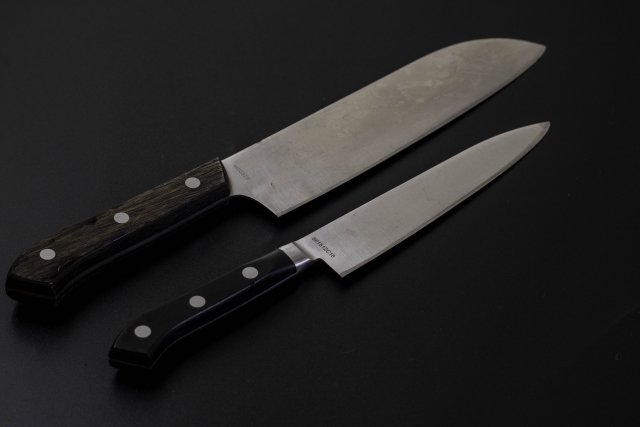
Stainless steel knives are made from carbon steel that contains chromium (10.5% or more) and has a carbon content of 1.2% or less. The addition of chromium forms a layer of chromium oxide, which prevents rust by binding with oxygen before the oxygen can react with iron.
Compared to carbon steel knives, stainless steel knives may be slightly less sharp, but they offer sufficient cutting ability for everyday household use. The main advantage of stainless steel knives is their rust resistance. They are strong against rust, require less maintenance, and are widely used by both professionals and home cooks.
Pros :
- Excellent rust resistance due to chromium oxide layer
- Low maintenance compared to carbon steel knives
- Durable and suitable for everyday household use
Cons :
- Mildly less sharp
- A bit more effort to sharpen
Browse our Stainless Steel Knives.
Stainless Steel Grades and Types
Stainless steel comes in various grades, where the chromium content and the addition of other elements can be adjusted to create knives that offer a cutting performance comparable to carbon steel. Common grades found in the Japanese market include Coreless, Ginsan (Silver 3), VG10, AUS10, VG1, and Molybdenum steel, among others.
Main Types of Stainless Steel
Stainless Steel
A standard stainless material that is lightweight, easy to use, and relatively inexpensive. While it offers general cutting performance, its sharpness and durability are slightly inferior to other materials.
Molybdenum Vanadium Stainless Steel
A stainless steel that includes molybdenum and vanadium. Molybdenum helps the steel maintain its strength and properties even at high temperatures, offering significant benefits even in small amounts. On the other hand, vanadium strengthens the steel and enhances its wear resistance. By adding these elements to stainless steel, weaknesses such as limited strength are reinforced, and wear resistance is significantly improved.
Molybdenum Vanadium Stainless Steel offers excellent edge retention, is rust-resistant, and is durable. While it may be slightly harder to sharpen, it requires less frequent sharpening, making maintenance easier.
Our popular molybdenum vanadium steel kitchen knife.
VG10 (V Gold 10)
VG10 (also known as V Gold 10 (“gold” meaning quality)) is a high-quality stainless steel developed by Takefu Special Steel Co., Ltd. It combines the strengths of both carbon steel and stainless steel, making it an excellent choice for knife-making. With a high hardness (HRC 60 or above (For more details, see the explanation below.)), It offers cutting performance similar to that of carbon steel while maintaining the corrosion resistance typical of stainless steel. This allows VG10 to maintain a very sharp edge for an extended period. In Japan, it is highly regarded by both home users and professional chefs. Although VG10 is very hard, making it somewhat challenging to sharpen, it doesn’t require frequent sharpening, making maintenance easier and ensuring long-lasting performance.
Our Popular VG10 steel kitchen knife
HRC and Knives Hardness
HRC, or Rockwell C hardness, is a measure of a knife’s hardness determined using a Rockwell hardness tester. A higher HRC indicates a harder blade that retains sharpness longer, though it may also be more brittle and challenging to handle.
Guidelines
- Home-use knives: HRC 56-58 (Offers a balance of sharpness and flexibility, making it ideal for everyday use. Softer and easier to sharpen, but the sharpness may not last as long, requiring frequent maintenance.)
- Professional knives: HRC 60 and above (High hardness allows for precise cuts. However, the risk of chipping increases, and it becomes more difficult to sharpen.)
When choosing a knife, selecting the right hardness based on your intended use is also one of the important factors to consider.
About Damascus Steel Knives
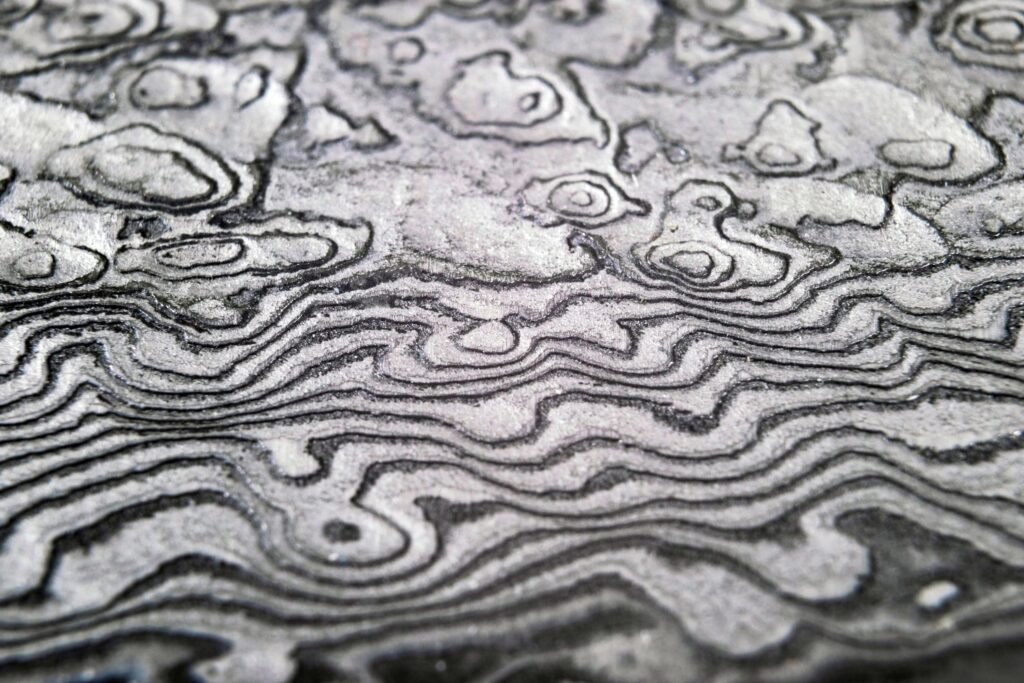
Damascus steel originally derives from “Wootz steel,” which was made in ancient India. Later, as sword-making became prominent in Damascus, the capital of Syria, it became known as “Damascus steel” after the city. The exact method of producing “Damascus” (or Wootz) steel from ancient India has been lost to history. Therefore, modern Damascus knives are made by layering various steels to recreate the appearance and characteristics of the ancient Wootz steel.
Pros :
- The beautiful Damascus pattern is visually striking
- Made from multiple layers of steel, they are strong and durable
- The high-quality core steel ensures long-lasting sharpness
Cons :
- Slightly higher cost
- Pattern may change with sharpening
About Powdered High-Speed Steel Knives
Powdered high-speed steel (powder metallurgy high-speed steel) is a high-hardness steel made using powder metallurgy, which forms fine and uniform carbide particles. This structure contributes to exceptional cutting performance. The small, evenly distributed carbide particles make the cutting edge sharp, providing excellent cutting ability that lasts longer. The fine carbide particles prevent segregation and distribute uniformly, ensuring a smooth and sharp edge for cutting tools. Additionally, powdered high-speed steel offers excellent properties such as high hardness, toughness, wear resistance, and corrosion resistance. These combined characteristics result in superior cutting ability and durability.
Pros :
- Excellent cutting performance due to fine carbide distribution
- High hardness maintains sharpness even under tough conditions
- Superior wear resistance for longer tool life
- Good toughness reduces the risk of chipping or cracking
Cons :
- Slightly higher cost
- More susceptible to damage
- Requires more effort to sharpen
Our powdered high-speed steel kitchen knife.
About Ceramic Knives
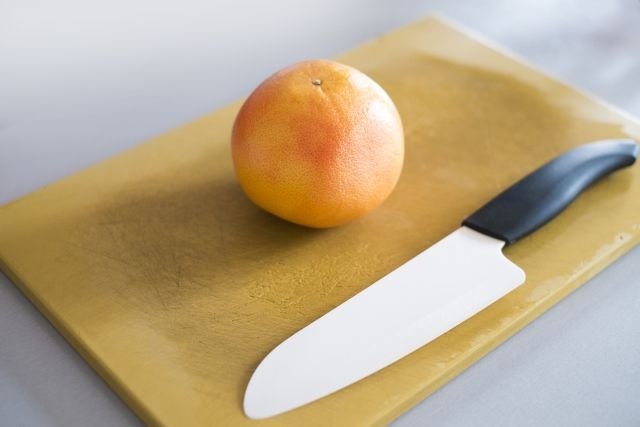
A ceramic knife is made from a type of ceramic material, which is a form of pottery. It is lighter than metal knives, rust-resistant, and easy to maintain, staying clean for a long time. Ceramic knives maintain their sharpness for an extended period and help preserve the flavor and prevent discoloration of ingredients. However, they are prone to chipping or breaking if dropped, so careful handling is required.
Pros:
- Lightweight and easy to handle for extended use
- Rust-resistant, making it low-maintenance
- Easy to clean as the smooth ceramic surface resists dirt and bacteria, ensuring hygiene with minimal effort
Cons:
- Prone to chipping
- Special tools required for sharpening
- Not ideal for hard foods
Please note: We currently do not stock ceramic kitchen knives.
How did you find the different knife materials we’ve covered this time? The market offers a wide variety of knives made from different materials and manufacturing processes, each varying in hardness, toughness, wear resistance, and corrosion resistance. We’ve also introduced some materials that are particularly popular in the Japanese market. Additionally, the right knife depends on the context—whether it’s for home use or professional cooking, whether you’re cutting delicate ingredients or tackling harder ones.
Beyond the blade material, the handle design, blade length, and, of course, your budget also play important roles in choosing the right knife.
Each product page lists the material used, so if you find a knife you’re interested in, be sure to check the material and compare it with the information in this blog to ensure you’re choosing the knife that’s best suited for your needs.
